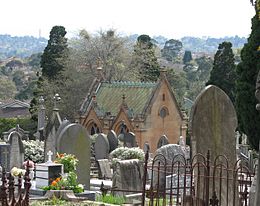Boroondara General Cemetery

General view with the Cussen Memorial in the middle ground.
|
|
| Details | |
|---|---|
| Established | 1859 |
| Location | Kew, Victoria |
| Country | Australia |
| Type | Public |
| Size | 31 acre (12.5 ha) |
| No. of graves | 75,000 |
| Website | Boroondara General Cemetery |
| Find a Grave | Boroondara General Cemetery |
| Footnotes |
|
Boroondara General Cemetery, often referred to as Kew cemetery, is one of the oldest cemeteries in Victoria, Australia. The cemetery, located in Kew, a suburb of Melbourne, is listed as a heritage place on the Victorian Heritage Register.
The 31-acre (13 ha) cemetery site was reserved in 1855 and trustees were first appointed in 1858. A site plan was drawn up by Frederick Acheson, a civil engineer in the Public Lands Office, with the layout segregated by religious denomination, a common occurrence at the time. The first burial took place in 1859.
In 1864 Albert Purchas, who was architect and surveyor for the Melbourne General Cemetery, joined the trust. Purchas is believed to be the designer of the landscape layout as well as many of the features of the cemetery including the cast iron entrance gates (1889), the rotunda (1890) and the surrounding ornamental brick wall (1895–6), as well as various additions to the original 1860 Cottage in the period 1866–1899 including the clock tower. The design of the cemetery was influenced by the Victorian garden cemetery movement. This influence was reflected in the curving path network following the contours of the site, the creation of defined views and a park like setting.
In the latter half of the twentieth century the cemetery was becoming full and many pathways and grassed verges were utilised to provide new burial sites. At the same time, many of the older Victorian monuments began to fall into disrepair due to their age and lack of funding to maintain them.
In 2001 the Peace Haven Mausoleum was built by the Cemetery Trust to cater for growing demand for above-ground burials.
The cemetery has had 75,000 burials since 1859. Among these are some very prominent Melburnians. The Syme memorial was constructed in 1908 in memory of David Syme, publisher of The Age newspaper. It has a temple-like appearance and Egyptian motifs. Between 1889 and 1907 the Springthorpe Memorial was constructed on behalf of Dr John Springthorpe in memory of his wife, Annie and in 1912 the Cussen Memorial was commissioned by Sir Leo Cussen, a judge of the Victorian Supreme Court as a memorial to his son, Hubert. The latter is a small chapel designed in the Gothic Revival style.
...
Wikipedia
